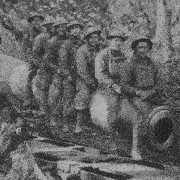|
I read about Goliaths when I was in Warsaw last summer. The fact that the Poles beat them by making all these short walls and called them Davids amused me to no end.
|
|
|
|

|
| # ? Jun 9, 2024 16:26 |
|
armor http://flashbak.com/world-war-1-body-armor-1914-1918-32670/ edit: it's all atavistic crap that crawled straight out of europe's id, and then georgian traditional fighting gear and cuirassiers. HEY GUNS fucked around with this message at 01:48 on Oct 30, 2015 |
|
|
|
I wanna dribe a Goliath in MarioKart
|
|
|
|
US Review of German Reconnaissance Tactics - March 1945 posted:While scouting a woods, a favorite German ruse is to drive the leading car toward its edge, halt briefly to observe, and then drive off rapidly, hoping to draw fire that will disclose the enemy positions. "Oh poo poo, we've been spotted, shoot it!" I wonder what the success rate was...
|
|
|
|
Koesj posted:First of all, what is interdiction? That's not meant to be a gotcha question mind you, I'd like to know what what we're arguing about in the post-WWII context Awesome! Thank you! In the WW2 context, my understanding is that it was using medium bombers to hit targets en route to the battlespace or to hit infrastructure. I know that the P-47 and Typhoon were used in this role, and greatly feared by the Germans but I was thinking more of the level bombers. I believe that in Korea, the A-26 was used in this role. In the post WW2 context, I'm thinking of the very expensive swing-wing, TFR, advanced avionics, low level attack aircraft. You're quite right in saying that the Tornado, Su-24 and F-111 never faced a Fulda Gap scenario, so it is impossible to evaluate exactly how they would have done in the role they were designed for. Do you think - broadly - that the design philosophy behind them was workable? I agree that the F-111 was very effective in Desert Storm but is that due to the platform or a side-effect of PGMs coming of age? Tank-Plinking with Paveways was effective, but not the nape-of-the-earth, high speed mission it was designed to carry out.
|
|
|
|
Frosted Flake posted:In the WW2 context, my understanding is that it was using medium bombers to hit targets en route to the battlespace or to hit infrastructure. I know that the P-47 and Typhoon were used in this role, and greatly feared by the Germans but I was thinking more of the level bombers. I believe that in Korea, the A-26 was used in this role. I guess the main issue is how broad and varied the answer is. We're talking about interdiction tactics that span all 6 years of the war, in every theater, not to mention all the special cases. Also, would naval interdiction be considered a thing? What with air-dropped mines, etc. Either way, an interesting thing with regards to German interdiction tactics at the outbreak of Operation Barbarossa was the use of the SD-2 cluster bombs. Allegedly carried on all sorts of aircraft thanks to the cluster being carried in a large canister similar in size to regular bombs. Bf-109's, Stuka's, He-111's, etc, could all be fitted with them and deployed wherever they could go. The SD-2 was rather small, however, so its effectiveness was limited to Anti-Personnel or, at most, soft-skinned vehicles. Wikipedia states it has 3 different fuzes based on desired effect, and there's a link at the bottom to a NAVORD document for a source. German memoirs of the Eastern Front also make mention of Soviet aircraft interdicting convoys behind the frontline and using a mixture of armament: Bombs, bomblettes, cannons, rockets. The list of potential aircraft performing these tasks could be quite long.
|
|
|
|
Frosted Flake posted:In the post WW2 context, I'm thinking of the very expensive swing-wing, TFR, advanced avionics, low level attack aircraft. Again, that's a platform, not a mission. Numerous contemporary Cold War aircraft were able to execute the same kinds of missions albeit at shorter range, with a bumpier ride, maybe at higher risk, and not as efficiently. Dedicated aircraft like the A-6, A-7, Jaguar, Su-17, and MiG-27 - or multirole ones like the Viggen (which was first built in its ground attack variant anyway) and certain Mirages for that matter - were generally a lot less expensive than the F-111 or Su-24 and could do low-level strike up to and including precision-guided ones in a pinch. Also, the aforementioned nuclear strike/interdiction mission was taken up wholesale by Starfighters in NATO countries What you're thinking of are two really big planes built by the two really big players, and they might just as well be categorized as bombers in role, seeing as how for example the FB-111 for SAC was a thing. The Tornado came a bit later, was somewhat smaller, and IIRC not as troubled as a program, so if you want to talk comparative usefulness of expensive swing-wing strike aircraft I think it really comes down to exclusively discussing the Pig and the Suitcase on technical merit, and wholly separating them from the strike mission at that. So... probably the TFR Airpower thread? I don't know enough about the aircraft themselves. quote:You're quite right in saying that the Tornado, Su-24 and F-111 never faced a Fulda Gap scenario, so it is impossible to evaluate exactly how they would have done in the role they were designed for. Do you think - broadly - that the design philosophy behind them was workable? No. The Desert Storm Air campaign unfolded over a number of phases, and both the F-111 and Tornado were actually employed for low-level, or more often at least low-level penetration deep strike missions during the first couple of days. The tank plinking thing came after knocking out airfields, C3 sites, Tigris/Euphrates bridges, WMD production and storage facilities, energy infrastructure etc. Three F-111s were hit by air to air missiles fired by Iraqi planes as well, though none was lost, and _seven_ Tornados were shot down. Also, the 1986 strike on Libya was a textbook employment of the F-111s capability as well: hard hitting strikes at low level over an (in this case extremely) long range. Painting a pretty picture of some kind of leisurely stroll where these aircraft were never truly tested is false IMO. Furthermore, Fulda Gap delenda est. Koesj fucked around with this message at 04:57 on Oct 30, 2015 |
|
|
|
HEY GAL posted:edit: it's all atavistic crap that crawled straight out of europe's id, and then georgian traditional fighting gear and cuirassiers. Them teeny tiny bucklers, what the gently caress. Also Hey Gal's Link posted:Enter Bashford Dean and his team. Met armorers crafted a battle harness with complete torso protection, front and back, for about 8.5 pounds With pauldrons (shoulder guards), couters (elbow) and vambraces (forearm), add another 4 pounds With helmet — and Dean offered the two finest battle helmets of modern times — it all came to just over 15 pounds Quite wearable, you would think, given that U.S. soldiers’ full panoply today can reach 40pounds, close to 15th century full-body plate armor. What, really?
|
|
|
|
JcDent posted:Moreover, Dean’s panoply was fully cushioned with “vulcanized sponge-rubber,” and with the latest alloys, could stop a .45 ACP at 1000 ft. per second (and a rifle ball at 1250 ft. per second). A quick check of wikipedia indicates that common WW1 rifle cartridges tended to have at least twice that muzzle velocity. So.. it doesn't stop rifle shots.
|
|
|
|
HEY GAL posted:armor pro-click  was my favourite
|
|
|
|
 
|
|
|
|
That happens when "If I can't see them, they can't see me" doesn't work?
|
|
|
|
The Lone Badger posted:A quick check of wikipedia indicates that common WW1 rifle cartridges tended to have at least twice that muzzle velocity. So.. it doesn't stop rifle shots. Muzzle velocity, yes. But you'd have to press the rifle muzzle against the armour to do so. I'll let someone else calculate how much distance you need between yourself and the enemy sniper or machinegun nest to survive...
|
|
|
|
The Lone Badger posted:A quick check of wikipedia indicates that common WW1 rifle cartridges tended to have at least twice that muzzle velocity. So.. it doesn't stop rifle shots. I wouldn't want to be the guy in it, but maybe they'd have gotten closer before the dying started?
|
|
|
|
Frosted Flake posted:Is Air Interdiction successful? More specifically, were dedicated Interdiction Bombers successful? Koesj got to the central point here pretty quickly: interdiction is a mission, and it is done in concert with CAS, deep strike, offensive counter-air, and the litany of other missions that air forces take on during major combat operations. The Tornado and F-111 and Su-24 aren't really "interdiction" aircraft any more than an F-15 is a "defensive counter-air" aircraft. They're strike aircraft, and all three were/are extremely good at their assigned tasks. On paper at least I think the Tornado is the most capable, but the combat record of the F-111 is extremely impressive. El Dorado Canyon, for example, is one of the more impressive missions of the post-WWII era. As for the effectiveness of interdiction tactics, I had kind of sketched out an effortpost but I realized this interview says everything I would have, and probably better. It is a discussion with three USAF generals about interdiction starting in WWII through Vietnam, and it is a pretty honest and frank discussion about what went well and what didn't. It is also kind of funny how they discuss future capabilities...like ISR (wherein we're still deficient), drones (lol), and how fantastic cluster munitions should be (really lol). One point to underscore the mission versus platform issue: they talk about hitting things like railyards with heavy bombers in the context of interdiction; in other words, using a so-designated "strategic bomber" on interdiction missions.
|
|
|
|
Keldoclock posted:http://www.dancarlin.com/product/hardcore-history-56-kings-kings/ The only thing I know about ancient near east history is from the internet chat in general and "the ancient world podcast" by Scott Chesworth. I didn't know Carlin was done with WW1 though (it's been so long I forgot how it ended.)
|
|
|
|
Arquinsiel posted:Muzzle velocity is not impact velocity. Bullets might have slowed down a lot before the hit. By the time a bullet loses half of its speed, it has likely travelled far enough to not be able to hit anything in the first place. That amount of protection would not be adequate against rifles, but probably good against small explosive fragments.
|
|
|
|
Ensign Expendable posted:By the time a bullet loses half of its speed, it has likely travelled far enough to not be able to hit anything in the first place. That amount of protection would not be adequate against rifles, but probably good against small explosive fragments. Using machineguns for indirect fire support was definitely a thing in WW1. Even most military rifles had sights for long range volley fire because of course you'd want to display your élan by wasting ammo on some barely visible speck in the horizon.
|
|
|
|
Ensign Expendable posted:By the time a bullet loses half of its speed, it has likely travelled far enough to not be able to hit anything in the first place. That amount of protection would not be adequate against rifles, but probably good against small explosive fragments. Hmm. I'm inclined to feel like the truth is somewhere in the middle here. Wikipedia suggests rifle bullets lose about half their speed at 600 yards. https://en.wikipedia.org/wiki/External_ballistics Now, 600 yards is a pretty long distance for normal engagements, but for sniping, or bursts of plunging fire from rifle calibre machine guns? I dunno, it's plausible. The main use would be against shrapnel though.
|
|
|
|
Most of the way through the Carlin piece on Mesopotamian stuff and it's okay. Takes a while to get going because he leads in with a bunch of fluff about tangential stuff but it's all right once he goes into the back and forth earth-salting between the Assyrians and everyone else.
|
|
|
|
Ensign Expendable posted:By the time a bullet loses half of its speed, it has likely travelled far enough to not be able to hit anything in the first place. That amount of protection would not be adequate against rifles, but probably good against small explosive fragments.
|
|
|
|
100 Years Ago General Monro recommends evacuation of Gallipoli as soon as possible. Hopefully this means that the whole enterprise will be swiftly and efficiently brought to an end with a minimum of bahahahahaha no I can't keep writing that with a straight face ahahahahaaaaaaaa Ahem. Meanwhile, Third Isonzo slacks off again as an Austro-Hungarian divisional commander is getting seriously worried about his blokes and writes a lovely graphic report about what they're having to suffer, and Louis Barthas goes up into the "Trench of the Mill". He's even able to spot where the mill is!
|
|
|
|
One nice perk about working in a university library: I was talking military history books with our primary history librarian today, and mentioned one of the recurring WW2 naval favorites of this thread, The Last Stand of the Tin Can Sailors, was something I had to order through inter-library loan (we have Shattered Sword and Neptune's Inferno). Our history librarian noted that she has a lot of money left for ordering books and doesn't know military history well, so after I linked her the amazon for Last Stand and checked through our ILL system what other universities in the state have it, she's gone ahead and ordered Last Stand of the Tin Can Sailors for our library.
|
|
|
|
JcDent posted:Them teeny tiny bucklers, what the gently caress.
|
|
|
|
Siivola posted:Believe it or not, bucklers of about that size were a thing way back when mail armour like that was also a thing. What really gets me is the mail hanging down to protect their eyes. That doesn't look comfy at all! Looks a lot more comfortable than the same amount of solid steel wrapped around your head like an oven. Might do more to protect your eyes than traditional helmets with their eye slits. Heck, I wouldn't be surprised if your peripheral vision was better too, even with the chains in the way. Anyone worn something like that and would know? The closest thing I've worn is a fencing mask and the mesh on those leaves more than enough vision for close work.
|
|
|
|
HEY GAL posted:armor bahaaha http://flashbak.com/wp-content/uploads/2015/03/armour.jpg "I said, nobody beats The Drum."
|
|
|
|
Speaking of personal armour designed to defeat rifle bullets supposedly at 10 paces Ned Kelly''s gang wore armour that weighed 44 kg. Yet critically it left limbs vulnerable which allowed Kelly to be captured - you can't always just be taking fire behind a waist height obstacle except in first person shooters.
|
|
|
|
WW1 armoured development seems to have managed medieval and renaissance armoured development in 4 years. Gone from mail, to tin can, to half plate. It's really strange.
|
|
|
|
Didn't armor see very little use in WW1 though, aside from helmets? Like, most of the stuff we've seen are from test batches or tiny production runs or whatever?
|
|
|
Grand Prize Winner posted:Didn't armor see very little use in WW1 though, aside from helmets? Like, most of the stuff we've seen are from test batches or tiny production runs or whatever? Armor in general saw relatively little use from the 18th century up until the mid 20th century. The increasing commonality and power of firearms on the battlefield eventually made many types of military armor too heavy to comfortably wear (especially for lengthy battles) if they were strong enough to deflect bullets. That said, armor was always there. The 19th and early 20th century saw a ton of silk vests that would provide padding against pistol bullets, so a good way to stay a little more confident that you wouldn't be easily murdered. Tons of independent manufacturers tried to sell iron armor of varying qualities to American Civil War soldiers, and plenty of suits or cuirasses got bought with their pay. But against rifle bullets, the only option was metal too thick for most soldiers to handle. The Soviets tried in WW2 with their SN-42 breastplate, but anything bigger than an MP 40 would go straight through it. For the most part, WW2 and post-war armor was heavily padded flak vests for protecting against fragmentation (with optional steel or titanium plates). Armor started coming into vogue again in the latter half of the 20th century due to advances in materials technology. Titanium provided lighter armor plates than iron or steel, and synthetic fibers like Kevlar could reliably protect from even magnum-caliber handguns and shotguns while remaining relatively light and breathable. The PASGT armor system of the United States (and copied by many) from the 1980s included a flak vest with armor plates, which the 90s and 2000s replaced with Kevlar vests or plate carriers that could accept titanium or ceramic armor plates.
|
|
|
|
|
chitoryu12 posted:Tons of independent manufacturers tried to sell iron armor of varying qualities to American Civil War soldiers, and plenty of suits or cuirasses got bought with their pay. What were the official responses to this? Are there photos?
|
|
|
|
Wasn't there some company that made bibles with armor plate covers?
|
|
|
HEY GAL posted:lol Here's one example:  I'll post a little more in a few minutes. Switching to mobile.
|
|
|
|
|
Grand Prize Winner posted:Didn't armor see very little use in WW1 though, aside from helmets? Like, most of the stuff we've seen are from test batches or tiny production runs or whatever?
|
|
|
|
Can't really effortpost on mobile, but I'll try my best. The armor was mass produced, but determining quality was up to the individual. Camp peddlers were incredibly common in the Civil War just like in centuries past, following soldiers and selling both regular supplies and luxuries. Lew Smith was recorded as one of those peddlers whose wares included "bulletproof vests". They cost around $5 to $8 (roughly $108 to $147 today), which could be as high as half a soldier's monthly pay. Despite their advertising, steel or iron plates are incredibly heavy (the vests were a good 12 pounds) and stifling in the summer heat. Colonel Charles F. Johnson wrote of testing one of the vests in a letter to his wife, and found that a Minie ball would go straight through at 50 yards. Not many bodies were found on battlefields wearing them. The other big problem was manliness. Being a tough guy was even bigger then as it is now, and wearing armor on the battlefield would inevitably apply the stigma of a coward.
|
|
|
|
|
How thick would you need a steel plate to stop a standard rifle bullet and how heavy would the resulting body armor weighted anyway? And I'm mostly thinking about this in terms of exactly what degree of unnatural strength Nazi occult super science would have to impart onto their twisted abominations so they could carry it.
|
|
|
|
chitoryu12 posted:Can't really effortpost on mobile, but I'll try my best. A crafty sutler would cite this as evidence of success.
|
|
|
|
Monocled Falcon posted:How thick would you need a steel plate to stop a standard rifle bullet and how heavy would the resulting body armor weighted anyway? According to some dude on google you'll need at least 7mm for standard 30-06 and twice that for AP rounds. This cuirass is 1.5mm thick and weighs 7.3kg. Increase that to 7mm and it would weigh 34kg. Edit: A more complete suit of armour is 30kg at 1.5mm, or 140kg for a 7mm thick full suit. The Lone Badger fucked around with this message at 23:54 on Oct 30, 2015 |
|
|
|
The Lone Badger posted:According to some dude on google you'll need at least 7mm for standard 30-06 and twice that for AP rounds. But those penetration values are in RHA (Rolled Homogeneous steel Armor). Based on some other internet dude, you would need 8.75mm of mild steel or 17.5mm of wrought iron for standard 30-06.
|
|
|
|

|
| # ? Jun 9, 2024 16:26 |
|
golden bubble posted:But those penetration values are in RHA (Rolled Homogeneous steel Armor). Based on some other internet dude, you would need 8.75mm of mild steel or 17.5mm of wrought iron for standard 30-06. I assumed you'd use RHA for your infantry armour since you're already making shitloads of it for your tanks.
|
|
|








































